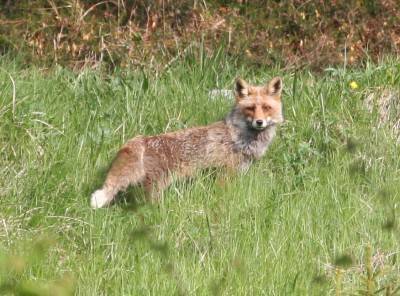
Length circa 65 – 75 cm
Weight: 8 – 10 kg
The fox is a medium sized canine, it has a long and tapered muzzle, erect, pointed and black in the back ears and short legs. Its appearance is pleasing, its thick fur is long, fluffy tail and coat color may change with the seasons.
È un animale notturno, ma vive indisturbato anche di giorno, riparandosi sotto i cespugli, in piccoli fossi, nelle tane scavate da lui stesso o in tane di tassi o istrici abbandonate.
The average life of a fox is around two years although these animals can reach 8-10 years.
Fox traces are well aligned and rarely have detours, unlike most of canines.
It is the wild carnivore with the largest area of distribution, present throughout Italy although it is not very common in the Po valley; it can thrive in a wide variety of habitats, from sea level to high mountains, including highly humanized environments and even in the suburbs and green areas of big cities. Anyway it still prefers woods interrupted by clearings, patches and bushes, with the proximity of crops.
In the mountains it prefers the forests and areas rich in hiding places up to 2,500 meters. It feeds on hares, rabbits, rodents, hedgehogs, but tends to exclude shrews and moles; it also eats insects, birds, eggs, earthworms, carrion and garbage. In summer and autumn its diet is supplemented with wild fruits and berries. Its food needs are about 500 gr. of food per day.
In January-February the males are courting the females and then occur pairs: usually the fox has a monogamous relationship and couples remain together until weaning of children. Births take place after about 50 days of gestation: in the first 15 days of life of females puppies do not let them ever and is the male to supply them with food.
Breastfeeding lasts one month, during which, however, adults bring to the babies also regurgitated food to supplement their diet. Weaning is completed in two months. In June, babies start following their parents in search of food and in late summer males leave the family to wander and face fights for the possession of a territory and to conquer a female. These competitive mechanisms prevent overcrowding and large fluctuations of this species, for which in fact the only limiting factor is the availability of food in addition to human persecutions.

